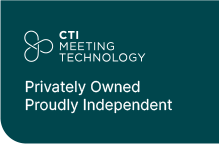Hybrid events have become an essential format in the events industry, combining the best of in-person and virtual experiences. Whether you’re planning your first event or are a seasoned meeting planner, you might need some guidance in navigating this unique format.
This guide will take you through every step of planning a successful hybrid event, from defining your goals to executing your event seamlessly. Keep reading to discover how to make the most out of your hybrid meetings.
The Benefits
- Increased Reach and AccessibilityHybrid events remove geographical barriers and offer your attendees options for how they consume meeting content. Whether they physically attend sessions or join remotely from the comfort of their home, they can consume the event content and enjoy the same experience as those at the venue.Events like the global pandemic in 2020 only highlight the importance of inclusivity and relying on technology to connect with each other. Especially for international conferences or organizations with global audiences, it allows your participants to connect even when the time zones are different, as they are busy. Not only that, but it also contributes to reducing CO2 emissions by eliminating the need for long-haul flights.
- Enhanced EngagementWhile some may argue that face-to-face interaction is superior, you should consider different cultures and personalities. Some people might not be comfortable getting on a stage and asking their questions publicly, but by introducing tools like live Q&As, chat rooms, or polls, hybrid events enable seamless interaction. Whether or not your attendees are at the venue, they can create a more connected experience.
- Cost EfficiencyWhile in-person events require venue rentals, catering, and travel expenses, hybrid events reduce costs by allowing some attendees to join remotely. Just think how many more areas can be improved – such as booking better speakers – by saving money on in-person resources.
- SustainabilitySustainability should be a key consideration for event organizers. By implementing a hybrid format with a remote element, you can reduce the environmental impact of your event and contribute to more sustainable practices.Hybrid events lower the carbon footprint associated with traditional conferences by reducing the need for travel and supporting sustainability initiatives. You can read more about the environmental impact of in-person meetings in this blog post.
- Comprehensive Data CollectionThe online component of hybrid meetings usually offers in-depth analytics, helping event organizers track engagement and measure ROI to improve future events. Analytics help gauge your efforts, but gathering comprehensive data during in-person meetings is challenging.
The Challenges
However, not everything about hybrid events is straightforward. As an organizer, be careful when choosing the format that best fits your conference. That might not mean a hybrid meeting, and that’s completely fine! Even if you go hybrid, you should know all the unique challenges that it presents:
- Technical Issues: Glitches with internet connection, audio, or streaming can disrupt virtual participation.
- Audience Engagement: Keeping remote attendees engaged can be challenging compared to in-person interactions, even when leveraging interactive tools.
- Budget Allocation: Balancing your budget between physical and digital event components can be complex, and event technology is usually expensive.
- Speaker Management: Ensuring speakers engage in-person and virtual audiences effectively requires additional preparation.
Why Even Host a Meeting?
Before getting into the details, clearly define the purpose of your event. Are you looking to educate your audience? Is lead generation your main focus?
Once you’ve answered these questions, evaluate if a hybrid format aligns with your objectives and audience preferences. If the answer is yes, then by all means, go ahead with your hybrid meeting! This preliminary step ensures a strong foundation to meet your event goals.
Build Your Conference Strategy
Next, you’ll need to develop your event strategy. This aspect is somewhat different from traditional meetings since there is an added virtual component.
- Identify your target audience and their preferences.
- Determine the ideal mix of virtual and in-person experiences.
- Decide on content formats such as keynote speeches, panels, breakout sessions, and networking events.
Choose the Right Technology
For a seamless hybrid experience, event technology is a must. The right tech provider can make or break an event. Moreover, as technology evolves, it can be a deciding factor for attendees attending your conference versus a competitor’s.
A study by Freeman revealed that 44% of attendees believe technology enhances the event experience, and this trend is on the rise. The traditional mindset of managing every aspect of your meeting in-house is outdated. Now, it’s vital to collaborate with partners who understand your goals and can support your technological needs.
From streaming to networking features, event technology enriches the event experience for online and onsite attendees. Furthermore, accessibility can be improved with closed captioning, live translations, or multilingual support. Ensure your chosen platform is user-friendly and can accommodate live and recorded sessions for a complete attendee experience.
Build Your Dream Team
Hybrid events, just like traditional ones, consist of many moving parts and require a well-structured team to manage every step:
- Event Manager: Oversees overall execution.
- Technical Support: Handles streaming, troubleshooting, and platform integration.
- Speaker Coordinator: Ensures presenters are well-prepared.
- Financial Specialist: Helps the organization to stay within the budget and prioritize tasks.
- Marketing Team: Promotes the event through various channels.
Clearly assigning roles will streamline execution and prevent last-minute confusion. Don’t hesitate to outsource tasks if necessary; having skilled professionals by your side will help you achieve better outcomes.
Choose an event technology partner that offers support services from start to finish.
Determine Your Budget
Another difference with traditional conferences is the budget. As an event planner, you might need to consider extra expenses when budgeting for a hybrid event:
- Technology Costs: Streaming platforms, virtual engagement tools, and tech support.
- Venue Expenses: Space rental, catering, and on-site AV support.
- Speaker Fees: Compensation for both in-person and virtual speakers.
- Marketing & Promotion: Digital ads, social media campaigns, and email outreach.
- Attendee Experience: Swag bags, networking events, and interactive elements.
A well-structured budget ensures a balance between the in-person and virtual experience so all attendees get the experience they expect, regardless of the format.
Choose The Right Venue
You’ll still need to select a venue for your in-person attendees. Understanding how many attendees will join online will help you determine the venue size—and cost. Picking the right venue for a hybrid meeting involves:
- Reliable Internet Connection: High-speed Wi-Fi to support live streaming.
- AV Capabilities: Microphones, cameras, lighting, and on-site tech support.
- Flexible Space: Rooms that accommodate both in-person and virtual interactions.
- Backup Plan: Have contingency options in case of technical failures.
Plan the Agenda
A well-structured agenda ensures a seamless hybrid experience. By balancing live and virtual content, attendees can avoid long sessions without engagement. Additionally, providing on-demand content ensures attendees can access recorded sessions they might have missed. This approach also boosts engagement, as attendees can potentially complete the whole event agenda and review those sessions that were the most interesting.
The on-demand component of the meeting offers an extra layer of data for organizers. You can gauge your attendees’ interest in any topic by checking which sessions are the most replayed. Moreover, by including interactive sessions, such as networking lounges, Q&As, or polls, you can get relevant information that can be used post-event.
Build Your Event Website
Your event website is the gateway that potential attendees must navigate before registering. Ideally, it should contain comprehensive information about the upcoming event and an easy registration process. The event site should also reflect your organization’s values and identity, making it customizable. As a guideline, it should include:
- Event Overview: Key details about speakers, sessions, and schedules.
- Registration Portal: Easy sign-up options for in-person and virtual attendees.
- Announcements: Inform of any updates regarding your conference.
- FAQs & Support: Provide technical assistance for your participants.
Time to Promote!
Marketing is essential to attract attendees. Rely on your Marketing and Communication team to develop the promotional strategy for your event, and don’t hesitate to get creative! Attendees see countless posts daily, so you must ensure your message stands out and leads them to register. Use a combination of channels to appeal to your audience:
- Email Campaigns: Target past attendees and new prospects.
- Social Media: Engage audiences through your organization’s social media channels, including LinkedIn, Twitter, or Instagram.
- Paid Ads: If your budget allows, invest in PPC campaigns to reach a broader audience.
- Partnerships: Collaborate with industry leaders and partners to increase event visibility.
Engage Your Audience
Sitting through hours of online lectures can be boring. Especially with multiple sessions during the day, Zoom fatigue can hit your remote attendees hard, so implement interactivity tools that keep your attendees engaged:
- Live Polls & Q&As: Encourage participation in every session.
- Gamification: Leaderboards, quizzes, and polling.
- Breakout Sessions: Small-group discussions for networking.
- Hybrid Networking Events: Virtual lounges or hybrid meetups.
Reinvent Sponsorship Opportunities
Sponsorships add value to your event while helping you offset costs, but they can be complex to manage. Presenting innovative sponsorship options, like virtual exhibition booths, can help distinguish your meeting from competitors. More importantly, the engagement data from the virtual elements helps demonstrate ROI and establishes lasting partnerships with your sponsors.
Other options include:
- Branded Sessions: Sponsors can lead discussions or host webinars.
- Merchandise: Deliver promotional materials to virtual attendees.
- Logo Placement: Sponsor branding on websites, emails, and event screens.
Test & Rehearse
The virtual component of a hybrid event introduces extra challenges. To make sure that everything is 100% ready to go on conference day, you need to test every scenario beforehand and make any necessary adjustments:
- Tech Rehearsals: Test streaming platforms and AV equipment.
- Speaker Training: Ensure presenters know how to engage both audiences.
- Engagement Features: Check chat functions, Q&As, and networking tools.
- Backup Plans: Have solutions in place for technical difficulties.
Use Your Data
Event technology helps gather more detailed data about attendees’ behavior and preferences. After the event, analyze key metrics and make adjustments for future conferences. Ask yourself: Which sessions were the most popular? Did the virtual component bring more sign-ups? Did attendees use the event technology correctly?
Answering these questions will help you assess whether hybrid was the appropriate format and guide any updates for future events. Pay particular attention to:
- Attendance Rates: Compare in-person vs. virtual participation.
- Engagement Levels: Monitor interactions, Q&A participation, and networking activity.
- Session Popularity: Identify the most viewed or attended sessions.
- Feedback Surveys: Collect insights on attendee experiences.
Wrapping Up…
Hybrid events are here to stay, as attendees appreciate the flexibility, engagement, and accessibility of this format. With this guide, we hope you can create enjoyable experiences that cater to diverse audiences while leveraging the latest technologies.
With careful planning, hybrid events can deliver powerful networking opportunities, seamless content delivery, and memorable attendee experiences. Ready to plan your next hybrid event? Partner with an event technology provider that offers all-in-one solutions that support your goals.






